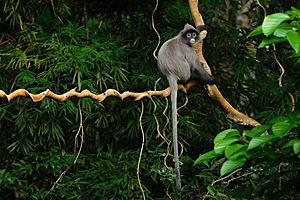Phayre's leaf langur facts for kids
The Phayre's leaf langur (scientific name: Trachypithecus phayrei), also called Phayre's monkey, is a type of Lutung. These monkeys live in the forests of Southeast Asia. You can find them in places like Northeast India, Bangladesh, Myanmar, Thailand, Laos, Vietnam, and China. They spend most of their lives high up in trees. Their main food source is leaves from many different kinds of trees.
Contents
Discover the Phayre's Leaf Langur
Phayre's leaf langurs are fascinating monkeys. They are known for their unique looks and how they live in the forest. These animals are an important part of the ecosystems where they live.
What Do Phayre's Langurs Look Like?
These langurs have a distinct appearance. They usually have dark grey or black fur on their bodies. Their faces are often lighter, sometimes with white rings around their eyes. This makes them look like they are wearing glasses! Young langurs are born with a bright orange or yellowish fur. This color changes as they grow older. They also have long tails, which help them balance as they move through the trees.
Where Do Phayre's Langurs Live?
Phayre's leaf langurs are found across a wide area in Asia. They prefer to live in different types of forests. This includes tropical evergreen forests and deciduous forests. They are very good at living in trees. They spend most of their time climbing, jumping, and resting high above the ground. Their forest homes provide them with food and shelter.
What Do Phayre's Langurs Eat?
As their name suggests, "leaf langurs" mostly eat leaves. They are herbivores, meaning they only eat plants. Besides leaves, they also munch on fruits, flowers, and buds. Their digestive system is specially designed to break down tough plant material. This diet helps them get all the nutrients they need from the forest.
How Do Phayre's Langurs Behave?
Phayre's langurs are social animals. They live in groups, usually with one adult male and several females and their young. These groups communicate using different sounds and body language. They are active during the day, which means they are diurnal. They spend their days foraging for food and resting in the trees. Their arboreal lifestyle keeps them safe from predators on the ground.
Why Are Phayre's Langurs Important?
Like many animals, Phayre's leaf langurs face challenges. Their forest homes are sometimes cut down. This makes it harder for them to find food and safe places to live. Protecting these langurs helps protect their forest habitats. This is good for many other plants and animals that live there too. Conservation efforts aim to ensure these amazing monkeys can thrive for future generations.


